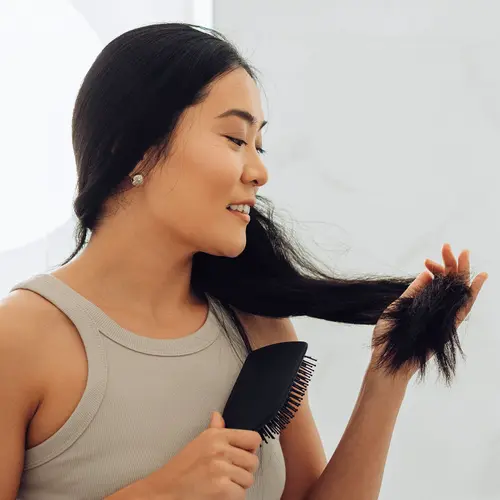Would you wash a cashmere sweater the same way you would a cotton T-shirt? If you do, you won't like the results. The same is true if you treat frizzy hair with a conditioner meant for straight, silky tresses -- or vice versa. For results you’ll love, learn how to choose the right conditioner for your hair type.
Hair requires special care. "Some of us have strands similar to wool, and others are more like silk," says internationally renowned stylist Sherri Jessee. "To have the most beautiful locks possible, it is very important to utilize the correct maintenance regimen." That means choosing the right conditioner for your hair type. Recognizing the signs that you have the wrong one is sometimes more obvious than others.
Sign #1--Your conditioner doesn't match your stylist's advice.
Your stylist is like your own personal guru -- at least when it comes to hair care suggestions. That's why Jessee's number one tip is to ask for advice at the salon -- then follow it!
"Your professional stylist can help you pick the right product that is good for your hair type," she says. She'll consider the texture of your hair and what chemical treatments you've had done to make a recommendation.
Sign #2--Your hair is colored, and you're not using a color-safe product.
If you don't use color-safe conditioner and shampoo on color-treated hair, then "what you've paid to put in there, you're washing away," Jessee says. It's like watching your money go straight down the drain.
Using the right color-safe conditioner will keep blonde brighter and brunette bolder. You may get 2 more weeks out of your hair color before you have to pay for another one.
Labels on color-safe conditioners use terms like "color extend," "color care," and "sulfate-free." They protect against the dulling effects of washing and over styling -- two of the main reasons hair color fades, Jessee says. Products with "UVA/UVB protection" offer a layer of protection to prevent the sun from fading your color, she says.
Sign #3--You're using volumizing conditioner on big, curly hair. Or, you're using a smoothing one on flat, fine hair.
When you use conditioner, "You're doing one of two things to hair--you're making it bigger, or you're making it smaller," Jessee says.
If your hair has lots of volume, you need a conditioner heavy enough to give you the amount of smoothing you need to tame frizzies and flyaways and get hair back under your control, Jessee says.
If your hair is fine and flat, you need a lighter conditioner. "If somebody has fine hair, and they use a smoothing treatment, it's going to feel oily, limp, and lifeless," Jessee says. Use a lighter-weight product that won't weigh down fine hair, she advises.
Sign #4--You have dry hair, and you're using a strengthening shampoo.
Extra strength won't help dry hair. If you're not getting enough moisture then you're not treating the true problem, Jessee says. "It's kind of like eating a steak when you're thirsty."
Dry, damaged hair needs a rich, moisturizing daily conditioner. At least once a week, revive parched hair with a deeper, leave-in conditioning treatment. Once a month, have it done at a salon.
Sign #5--You bought the most expensive conditioner.
While you don't want to buy the cheapest conditioner in the store, you also don't need to spend $100, or even $30. A conditioner that is five times more expensive won't necessarily make your hair look five times better. Some experts say that once you get past the $5 range, you're not adding much value to your hair.
Once you get the best conditioner for you, use it right. These are Jessee's recommended steps:
- Shampoo the roots
- Condition the ends. That's where damage like split ends occurs
- Only in rare cases do you need to deep condition the scalp
- Use a wide-toothed comb to evenly distribute the conditioner throughout your hair. Keep one in the shower just for this.

